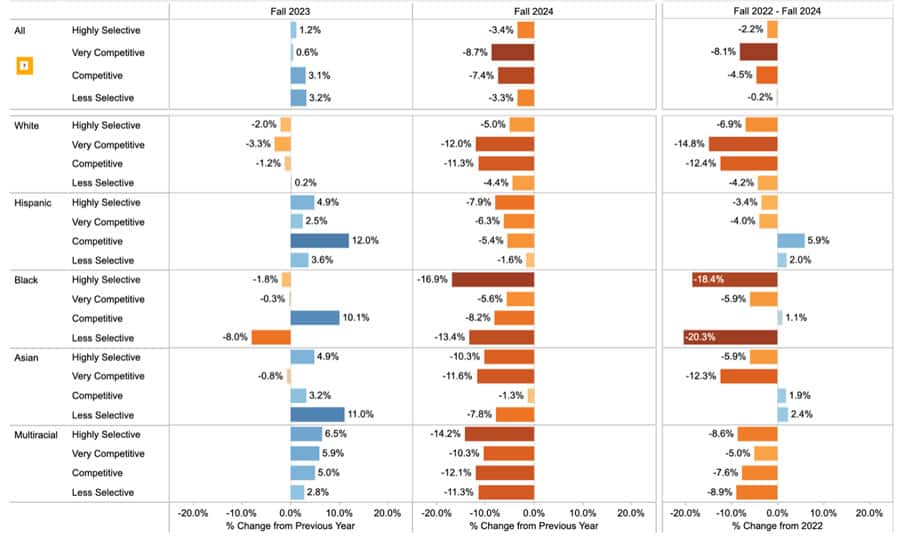First-year college students in the US down by more than 6% ahead of projected “enrolment cliff”
- First-year domestic enrolments of 18-year-olds in US four-year colleges declined by over 6% in fall 2024 compared with fall 2023
- A systemic failure preventing students needing financial aid from receiving confirmation of that aid soon enough to be admitted for fall 2024 played a major role
- International students are likely to be even more important for US colleges if these domestic enrolment trends continue as expected
A new data analysis reveals worrisome trends for US colleges with respect to domestic first-year enrolments. The number of 18-year-olds entering US higher education is falling – and just as the so-called “enrolment cliff” is projected to begin in 2026. The enrolment cliff refers to an expected drop in the population of high-school graduates, which translates to a smaller pool of domestic students able to enter postsecondary programmes.
That higher education enrolments are already dropping – following a recovery in 2022 and 2023 after the pandemic – shows that the demographic effects of the enrolment cliff will be exacerbated by other factors (e.g., economic, attitudinal, and financial). This suggests that US colleges could become more reliant on international students’ tuition, as well as alternative delivery models and revenue sources.
An average 5% drop
The National College Attainment Network (NCAN), which advocates for equity in higher education, looked at data from the National Student Clearinghouse Research Center on roughly 1.4. million 18-year-olds enrolled in close to 80% of US postsecondary institutions. The analysis found that enrolments declined by 5% across all sectors in fall 2024 compared with fall 2023.
That was the average decline: it was steeper at four-year colleges. As shown in the chart below, four-year colleges experienced declines of over 6% between 2023 and 2024. Public two-year colleges – which are less expensive and which require less time commitment – were not hit as hard.
What’s more, declines happened in 46 US states: only Alabama, Delaware, Louisiana and Washington DC saw moderate increases (about 3%) in first-year enrolments, while there was no change in Oklahoma.

NCAN CEO Kim Cook said:
“This semester’s enrollment numbers for high school graduates should be frightening for practitioners, policymakers, and the public alike. Our progress toward increasing college enrollment coming out of the pandemic has been stymied, and we will have to work much harder to help many of these students to rediscover college pathways in the future.”
Race and income tell a story
The extent of enrolment declines differed according to how competitive a college is to gain admission to. Overall, the most selective institutions (e.g., Ivy League or elite liberal arts colleges) as well as the least selective (at the other extreme) experienced relatively mild falloffs. It is possible that determination to earn a degree is highest among (1) high-school students with the grades/income to gain admission to an elite university and (2) students with lower academic standing and/or greater concerns around affordability who will study at a less prestigious institution as long as they earn a degree.
The middle categories of institution – “very competitive” and “competitive” – saw the greatest overall drops in first-year enrolments of 18-year-olds.
In terms of race:
- “Highly selective” institutions saw the largest declines among Black, multiracial, and Asian students (-16.9%, -14.2%, and -10.3%, respectively).
- “Very competitive” institutions saw the steepest falloffs from white and Asian students (-12% and -11.6, respectively).
- “Competitive” institutions saw the biggest drops from multiracial, white and Black students (-12.1%, -11.3%, and -8.2%, respectively)
- And “less selective” institutions (i.e., the easiest category to gain admission to) experienced the greatest losses from multiracial students (-11.3%).

Income was another major predictor of enrolment trends. NCAN writes:
“Declines were also pronounced at colleges serving the most students from low-income backgrounds (i.e., Pell Grant recipients). Without knowing if these students instead matriculated to other institutions, it may be that these students did not enroll at all and may never do so in the future.”
A systemic blunder played a major role in the growing tendency of lower-income students to not progress from high school to postsecondary studies. There was a “disastrous rollout” of the federal application and federal student aid (FAFSA) online platform in the spring of 2024. FAFSA opened late and then was plagued by technical issues, with the result that many students received their letter confirming their financial award after decision deadlines. Without an award, many of those students would not have been able to afford postsecondary education.
In an email to University World News, Bill DeBaun, NCAN’s senior director of data and strategic initiatives, wrote:
“If an award letter came after decision deadlines, for example, students may have made the difficult decision not to matriculate this semester. If students from low-income backgrounds, who are often Pell Grant recipients, were disproportionately affected, the institutions to which they tend to matriculate were too.”
Access to prestigious institutions is lower following Supreme Court decision
Another factor in the overall decline was the June 2023 ruling of the US Supreme Court that the consideration of race as a factor in college admissions decisions was unconstitutional. Almost certainly related to that ruling is the fact that enrolments of first-year Black 18-year-olds declined dramatically in fall 2024 at the most selective four-year institutions.
Many students will be lost forever to the postsecondary system
NCAN writes:
“Too many students missed a college transition this fall. Past research has shown that students who delay entry to college have a decreased likelihood of future degree attainment. More recently, NSCRC research showed that among high school graduates from the class of 2020, just 2% of students followed a ‘gap year’ enrollment pattern where they enrolled for the first time more than a year after high school graduation.
Given that there have been disruptions to both FAFSA completion and enrollment for three of the last five graduating high school classes, getting the class of 2025 back on track for enrollment next fall is critical. The stakes for students and their families and communities, as well as states and the United States overall, are very high. It is important that the enrollment declines resulting from these disruptions not become our new national normal.”
For additional background, please see:
- Attend ICEF USA, a specially curated event taking place immediately after the NAFSA 2025 Annual Conference in order to meet with top ICEF-accredited education agencies from around the world.
- “Are US colleges ready for the projected enrolment cliff?”
Most Recent
-
ICEF Podcast: Together for transparency – Building global standards for ethical international student recruitment Read More
-
New analysis sounds a note of caution for UK immigration reforms Read More
-
The number of students in higher education abroad has more than tripled since the turn of the century Read More
















